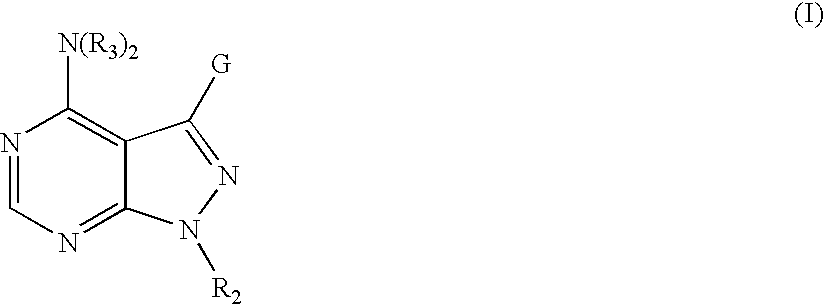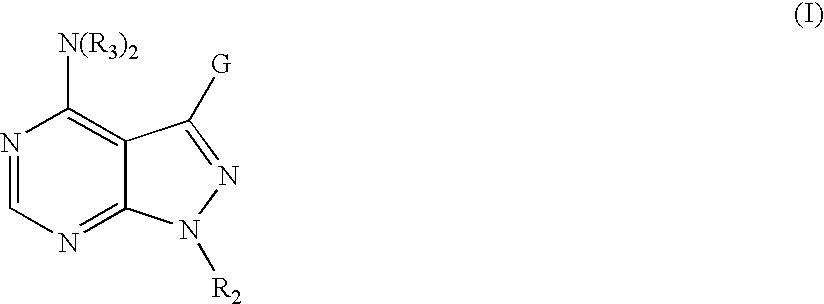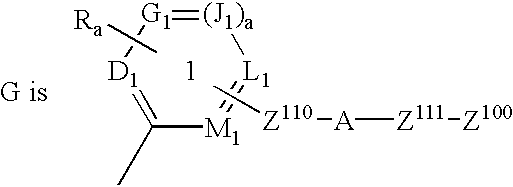Pyrazolopyrimidines as therapeutic agents
a technology of pyrazolopyrimidine and pyrazolopyrimidine, which is applied in the direction of metabolism disorder, extracellular fluid disorder, immunological disorders, etc., can solve the problems of endothelial cell death, loss of vascular structure and matrix contacts, and inability to fully understand the role of pyrazolopyrimidine in normal physiological and disease processes
- Summary
- Abstract
- Description
- Claims
- Application Information
AI Technical Summary
Benefits of technology
Problems solved by technology
Method used
Image
Examples
example 1
N1-(4-{4-amino-1-[4-(morpholinomethyl)phenyl]-1H-pyrazolo[3,4-d]pyrimidin-3-yl}-2-methoxyphenyl)-2-fluoro-4-(trifluoromethyl)benzamide
[0534]A mixture of N1-{4-[4-amino-1-(4-formylphenyl)-1H-pyrazolo[3,4-d]pyrimidin-3-yl]-2-methoxyphenyl}-2-fluoro-4-(trifluoromethyl)benzamide (Intermediate 2) (0.075 g, 0.14 mmol), morpholine (0.024 mL, 0.27 mmol), and sodium triacetoxyborohydride (0.087 g, 0.409 mmol) in dichloroethane (1.4 mL) was shaken at ambient temperature for 16 h. Additional portions of morpholine (0.012 mL, 0.14 mmol), sodium triacetoxyborohydride (0.043 g, 0.20 mmol), and acetic acid (0.016 mL) were added and the reaction mixture was stirred at ambient temperature for 24 h. 1 N NaOH (1 mL) was added and the reaction mixture was filtered to afford a gray solid which was purified by preparative RP-HPLC (Rainin C18, 8 μm, 300 A, 25 cm; 10-60% acetonitrile—0.05 M ammonium acetate over 25 min, 21 mL / min); the fraction eluting from 21-23 min was collected, concentrated, and lyopho...
example 2
N1-[4-(4-amino-1-{4-[(4-hydroxypiperidino)methyl]phenyl}-1H-pyrazolo[3,4-d]pyrimidin-3-yl)-2-methoxyphenyl]-2-fluoro-4-(trifluoromethyl)benzamide monoacetate
[0535]A mixture of N1-{4-[4-amino-1-(4-formylphenyl)-1H-pyrazolo[3,4-d]pyrimidin-3-yl]-2-methoxyphenyl}-2-fluoro-4-(trifluoromethyl)benzamide (Intermediate 2) (0.075 g, 0.14 mmol), 4-hydroxypiperidine (0.028 g, 0.27 mmol), and sodium triacetoxyborohydride (0.087 g, 0.41 mmol) in dichloroethane (1.4 mL) was shaken at ambient temperature for 16 h. Additional portions of 4-hydroxypiperidine (0.028 g, 0.27 mmol) and acetic acid (0.016 mL) were added and the reaction mixture was shaken for 24 h. More 4-hydroxypiperidine (0.033 g, 0.33 mmol) and sodium triacetoxyborohydride (0.040 g, 0.19 mmol) were added and the reaction mixture was shaken for 72 h. 1N NaOH (1.5 mL) was added and the yellow-brown precipitate was collected by filtration and purified by preparative RP-HPLC (Rainin C18, 8 μm, 300 A, 25 cm; 10-60% acetonitrile—0.05 M amm...
example 3
N1-{4-[4-amino-1-(4-{[4-(2-hydroxyethyl)piperazino]methyl}phenyl)-1H-pyrazolo[3,4-d]pyrimidin-3-yl]-2-methoxyphenyl}-2-fluoro-4-(trifluoromethyl)benzamide
[0536]A mixture of N1-{4-[4-amino-1-(4-formylphenyl)-1H-pyrazolo[3,4-d]pyrimidin-3-yl]-2-methoxyphenyl}-2-fluoro-4-(trifluoromethyl)benzamide (Intermediate 2) (0.075 g, 0.14 mmol), N-(2-hydroxyethyl)piperazine (0.035 g, 0.27 mmol), and sodium triacetoxyborohydride (0.087 g, 0.41 mmol) in dichloroethane (1.4 mL) was shaken at room temperature for 14 h. Additional portions of N-(2-hydroxyethyl)piperazine (0.010 g, 0.077 mmol) and sodium triacetoxyborohydride (0.020 g, 0.094 mmol) were added and the reaction mixture was shaken for 16 h. 1N NaOH (1.5 mL) was added and the precipitate was collected by filtration and purified by preparative RP-HPLC (Rainin C18, 8 μm, 300 A, 25 cm; 10-60% acetonitrile—0.05 M ammonium acetate over 25 min, 21 mL / min); the fraction eluting from 21.9-22.9 min was collected, concentrated, and lyopholized to af...
PUM
| Property | Measurement | Unit |
|---|---|---|
| Mass | aaaaa | aaaaa |
| Mass | aaaaa | aaaaa |
| Mass | aaaaa | aaaaa |
Abstract
Description
Claims
Application Information
 Login to View More
Login to View More - R&D
- Intellectual Property
- Life Sciences
- Materials
- Tech Scout
- Unparalleled Data Quality
- Higher Quality Content
- 60% Fewer Hallucinations
Browse by: Latest US Patents, China's latest patents, Technical Efficacy Thesaurus, Application Domain, Technology Topic, Popular Technical Reports.
© 2025 PatSnap. All rights reserved.Legal|Privacy policy|Modern Slavery Act Transparency Statement|Sitemap|About US| Contact US: help@patsnap.com



